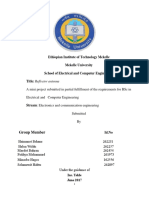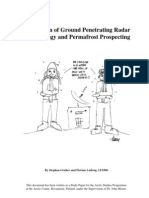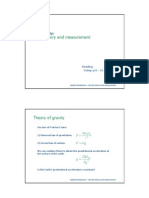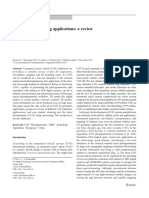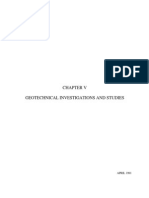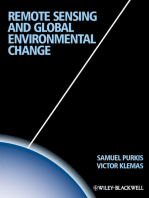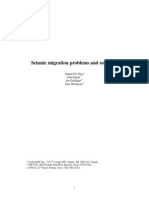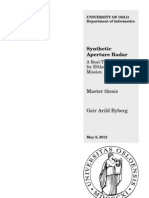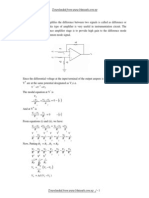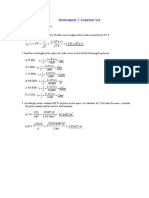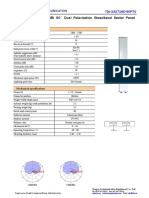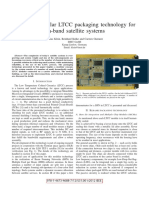GPR Processing
GPR Processing
Uploaded by
naivedya_mishraCopyright:
Available Formats
GPR Processing
GPR Processing
Uploaded by
naivedya_mishraOriginal Description:
Copyright
Available Formats
Share this document
Did you find this document useful?
Is this content inappropriate?
Copyright:
Available Formats
GPR Processing
GPR Processing
Uploaded by
naivedya_mishraCopyright:
Available Formats
6
Ground Penetrating Radar Subsurface Imaging
of Buried Objects
Francesco Soldovieri
1
and Raffaele Solimene
2
1
Institute for Electromagnetic Sensing of the Environment, National Research Council,
2
Department of Information Engineering, Second University of Naples,
Italy
1. Introduction
Ground Penetrating Radar (GPR) is a well assessed diagnostic instrumentation that finds
application in a very large range of sectors where the aim is of achieving information about the
presence, the position and the morphological properties of targets embedded in opaque media
is c crucial task. Therefore, it is of interest in many fields which range from civil engineering
diagnostics (Hugenschmidt & Kalogeropulos, 2009; Soldovieri et al. 2006), to archaeological
prospecting (Conyers & Goodman, 1997; Piro et al., 2003; Orlando & Soldovieri, 2008), to
cultural heritage management, to geophysics, only to quote a few examples.
Besides these classical fields of application, GPR methodology/technology is arising interest
in new fields related to the security framework such as: through-wall imaging (Baranoski,
2008, Ahmad et al. 2003; Solimene et al., 2009), tunnel and underground facility detection
(Lo Monte et al., 2009), borders surveillance.
Another field of recent interest is concerned with the exploration of planets; in particular,
satellite platform radars are just investigating the Marsis subsurface (Watters et al., 2006) for
the water search and other similar missions are under development for Lunar exploration.
GPR is based on the same operating principles of classical radars (Daniels, 1996). In fact, it
works by emitting an electromagnetic signal (generally modulated pulse or Continuous
Wave) into the ground; the electromagnetic wave propagates through the opaque medium
and when it impinges on a non-homogeneity in the electromagnetic properties (representative
of the buried target) a backscattered electromagnetic field arises. Such a backscattered field
is then collected by the receiving antenna located at the air/opaque medium interface and
undergoes a subsequent processing and visualization, usually as a 2D image.
Anyway, significant differences arise compared to the usual radar systems.
The first one is that while usually radar systems act in a free-space scenario, GPR works in
more complicated scenarios with media that can have losses and exhibit frequency-
dependent electromagnetic properties thus introducing dispersive effects.
Secondly, while the range of radars may be also of hundred of kilometres, in the case of GPR
we have ranges, also in the most favourable cases, of some meters due to the limited
radiated power and the attenuation of the signal.
Moreover, GPR resolution limits, which ranges from some centimetres to some metres (in
dependence of the working frequency), usually are smaller as compared to the ones of the
usual radar systems.
Source: Radar Technology, Book edited by: Dr. Guy Kouemou,
ISBN 978-953-307-029-2, pp. 410, December 2009, INTECH, Croatia, downloaded from SCIYO.COM
www.intechopen.com
Radar Technology
106
According to the working principles described above, the architecture of the radar system
can be schematised very briefly by the following blocks:
Electronic unit that has the task to drive and command the transmission and the
reception of the antennas and to send the collected data to a monitor or to a processing
unit;
Two antennas that have the task of radiating the field impinging on the target and
collecting the field backscattered by the target, respectively;
A monitor/processing unit that has the task of the subsequent processing and
visualization of the measurements collected by the receiving antenna.
From the schematization above, it emerges that a first advantage of the GPR
instrumentation resides in the moderate cost and easiness of employ; in fact no particular
expertise is required to collect the data. Secondly, the instrumentation is easily portable
(unless very low frequencies are exploited thus increasing the physical size of the antennas)
and allows to survey regions also of hundreds of square metres in reasonable time. Finally,
the flexibility of the GPR system is ensured by the adoption of antennas (mostly portable)
working at different frequencies and that can be straightforwardly changed on site.
It is worth noting that the necessities of probing lossy medium and of achieving resolution
of the order of centimetres poses a very challenging task for the antennas deployed in the
survey. On the other hand, as mentioned above, the portability of the system has to be
ensured so that no complicated and large antenna systems can be employed. In particular,
the trade-off between the necessity to have a large investigation range (that pushes to keep
low the operating frequency) and the aim of achieving good spatial resolution makes the
overall working frequency band exploited by GPR systems ranging from some tens of MHz
to some GHz.
Therefore, the antennas designed for GPR applications have to comply with the following
requirements: small dimension, ultra-wide-band behaviour and low levels of the direct
coupling between the transmitting and receiving antennas.
The most widespread antennas employed for GPR surveys fall within the class of
electrically small antennas such as dipole, monopole or bow-tie antennas.
Since these antennas are designed electrically small, the radiation pattern is broad and so
low gain is achieved; keeping broad the radiation pattern allows to exploit synthetic
aperture antenna which are particularly suitable to obtain focussing effect in the
reconstructions. In addition, these simple antennas radiate a linear polarisation but also
exhibit the drawback that relatively small frequency bandwidth is achieved. The working
frequency band can be enlarged by loading techniques and the most-widely used technique
is based on the application of resistive loading (Wu & King, 1965). The main disadvantage of
resistive loading is the considerable reduction of the radiation efficiency due to the ohmic
losses. In the last years, some approaches exploiting reactive elements to achieve the loading
effect have been presented. A very recent development is concerned with the loading
approaches based on the combination of resistive and capacitive loads; this offers the best
performances in terms of trade off between small late-time ringing (increase of the
frequency bandwidth) and high radiation efficiency (Lestari et al., 2004).
In addition, very recent advances are in course for adaptive (Lestari et al., 2005) and
reconfigurable antennas, already exploited in communication field. In particular, the
development and the implementation of RF/microwave switches have permitted the birth
of a new concept of the antenna as a device that can dynamically adapt its behaviour to
www.intechopen.com
Ground Penetrating Radar Subsurface Imaging of Buried Objects
107
different measurement situations and operational contexts thanks to the change of its main
parameters such as: input impedance, frequency band, radiation pattern. A design of an
antenna for GPR purposes, with a geometry completely reconfigurable within the frequency
band 0.31 GHz, and its performances compared to a reference bow-tie antenna are reported
in (Romano et al., 2009). The structure has been synthesized by means of the total
geometry morphing approach that represents the most structurally complicated but also
versatile design method exploited to achieve the reconfigurability of an antenna.
Another class of antennas very widespread is the frequency independent one made up of
spiral antennas (equiangular and conical). This kind of antennas are characterised by a
geometry that repeats itself and in most cases the geometry (as in the case of spiral
antennas) is completely described by an angle. Besides the frequency independent
behaviour, spiral antennas are able to radiate a circular polarization; this is useful when the
aim of the survey is to achieve information on objects that are elongated along a preferential
direction. Another kind of frequency independent antennas is the Vivaldi antenna where the
travelling wave energy is strongly bounded between conductors when the separation is very
small, while becomes progressively weaker and more coupled with the radiation field when
the separation increases. As main features, the Vivaldi antenna has an end-fire radiation
mechanism, and the beamwidth is about the same in both planes E and H; the gain is
proportional to the whole length and to the rate at which the energy is leaked away.
2. The measurement configuration and the radargram
Different configurations are adopted in GPR surveys and their choice is dictated by different
applicative motivations such as: the type of investigation to be made; the kind of targets to
be detected; the extent of the investigated region.
In general, all the reasons above push towards the adoption of the simplest acquisition
mode for which the GPR system works in a monostatic or bistatic configuration. In the
former case, the locations of the transmitting and the receiving antennas are coincident (or
very close in terms of the radiated wavelength), whereas in the second case the transmitting
and the receiving antennas are spaced by a fixed offset that is constant while they move
along the survey line.
By moving the antenna system along a selected profile (line) above the ground surface a
two-dimensional reflection profile (radargram) is obtained in which, for each location of the
antenna system, a trace is achieved where the amplitude and the delay time of the recorded
echoes (that can be related to the depth of the underground reflectors) is drawn (Daniels,
1996).
Such a radargram provides a rough information on the presence and the location of the
targets but the actual shape of the target is blurred due to the effect of the
propagation/scattering of the electromagnetic wave in the soil.
Such a statement is made clearer by considering the scattering by a point-object (an object
small in terms of the probing wavelength) that is imaged as a hyperbola in the radargram. In
fact, by denoting with x the position of the TX/RX system along the measurement line and
with (0,d) the position of the point-object , the two-way travel-time is given by
2 2
2 / t x d v = + (1)
www.intechopen.com
Radar Technology
108
where v is the velocity of the electromagnetic wave in the soil. Therefore, the recorded
data is represented as a hyperbola with a vertical axis and the apex at (0, 2d/v). Figure 1 is
a pictorial image of the consideration above.
Fig. 1. Pictorial description of the radar response of a point-object.
As a result, the shape of the hyperbola depends on the electromagnetic properties of the
investigated medium (electromagnetic velocity), the configuration (monostatic or bistatic)
and on the depth of the scatterer.
Besides the configuration said above, others acquisition modes can be deployed in the
survey. Among them, we recall the common midpoint (CMP) where the transmitting and
receiving antennas are further spaced during the survey but leaving the same the midpoint
between them. The adoption of this sounding configuration is particularly useful when one
aims at determining the velocity of the electromagnetic wave in the medium (Huisman et
al., 2003).
Further configurations are also exploited, but they have the drawback that are not
particularly simple, as the multi-fold ones where one transmitting antenna is located at a
fixed position while the backscattered field is collected by the receiving antenna moving at
different locations. The same measurement configuration can be further complicated by
repeating the measurement procedure for different location of the transmitting antennas.
All the configurations presented above are concerned with a reflection mode where both the
transmitting and receiving antennas are from the same side with respect to the investigation
domain (as for example in the case of subsurface prospecting).
A different mode can be considered for the case of the masonry structure as the
trasillumination or transmission mode where the transmitting antenna and the receiving
one are at the opposite sides of the structure under investigation.
3. GPR subsurface imaging
The aim of subsurface imaging is to obtain images of a scene which is buried in the soil in
order to reconstruct non-homogeneities perturbing the background medium.
This can be achieved at different degree of difficulty depending on what one may want to
retrieve. For example, one can be interested in detecting the buried scatterers only or even
in determining their geometrical sizes or, finally, the nature of scatterers can be of concern.
www.intechopen.com
Ground Penetrating Radar Subsurface Imaging of Buried Objects
109
From a mathematical point of view, subsurface imaging is a special case of inverse
scattering problem where, at microwave frequencies, the scatterers are reconstructed in
terms of a spatial map of their dielectric and/or conductivity features.
Accordingly, it is a non-linear and ill-posed problem whose solution generally requires to
set up some optimization procedure (deterministic or stochastic) (Chew, 2005; Pastorino, 2007).
Even though much work has been done in this field non-linear imaging schemes still suffer
from reliability problems due to the false solutions (i.e. local minima of the cost functional to
be minimized which can trap the optimization procedure) and are computationally
demanding both as far as time and memory resources are concerned. As a matter of fact,
these drawbacks hinder their use when imaging of a large (in terms of wavelength) spatial
region is required and when the time to achieve imaging is a constraint.
Fortunately, in many practical contexts detecting and localizing the buried scatterers is the
primary concern. This can be successfully achieved by adopting imaging algorithms based
on simplified scattering models which neglect high order effects due to mutual interactions
and which linearize thus the scattering equations. Indeed, the majority of the subsurface
imaging algorithms are implicitly or explicitly based in the linear assumption. This is
because, in the framework of scatterers localization and shape reconstruction linear imaging
algorithms work well far beyond the limits of validity of the scattering linear models upon
which they are founded (Pierri et al., 2006).
Here, we will consider only imaging algorithms based on linear models that are the most
widely employed in practical scenarios. Such algorithms can be substantially categorized in
two groups: migration algorithms and inverse filtering algorithms. Therefore, in the sequel we
will describe and compare such algorithms. In particular, starting from the linearized
scattering equations the way they are linked and the expected performance are derived
under an unified framework.
Before attempting to pursue such a task it must be said that the imaging algorithms are only
a part of the signal processing required in subsurface imaging. Most of the effort in signal
processing concerns primarily with the reduction of the clutter. In fact, while system noise
in GPR can be reduced by averaging, generally GPR data are heavily contaminated by
clutter which affects the capability of detecting the buried scatterers. The strongest clutter
mainly arises from the air/soil interface and different methods exist to mitigate such a
contribution (Daniels, 2004). Connected with this question is the problem of subsurface
dielectric permittivity and conductivity estimation. This problem is by its own of significant
interest in several applicative fields, ranging from agriculture to monitoring of soil pollution
and so on, and for this reason many estimation approaches have been developed. For
example the dielectric permittivity can be exploited as an indicator of the soil surface water
content (Lambot et al., 2008; Huisman et al., 2003).
However, for imaging purposes it is clear that if the electromagnetic properties of the soil
were known one could estimate the field reflected from the air/soil interface and hence can
completely cancel the corresponding clutter contribution. What is more, any imaging
schemes requires the knowledge of the soil properties to effectively achieve focusing;
otherwise blurred images where the scatterers appear smeared and delocalized.
4. Migration
Migration procedures essentially aim at reconstructing buried scattering objects from
measurements collected above or just at the air/soil interface (from the air side). They were
www.intechopen.com
Radar Technology
110
first conceived as a graphical method (Hagendoorn, 1954) based on high frequency
assumption. After this approach has found a mathematical background based on the wave
equation.
We illustrate the basic idea by assuming that the transmitting and the receiving antennas are
just located at the air/soil interface where data are taken accordingly to a multimonostatic
configuration (i.e., the receiver is at the same position as the transmitter while the latter
moves in order to synthesize the measurement aperture). Moreover, for the sake of
simplicity and according to the content of many contributions in the field of migration
algorithms, we develop the discussion neglecting the air/soil interface. This means that we
consider a homogeneous background scenario with the electromagnetic features of the
subsurface. Moreover, the arguments are developed within a two-dimensional and scalar
geometry so that the phenomena are described in terms of scalar fields obeying the two-
dimensional and scalar wave equation.
Consider a point-like scatterer located in the object space at ( , )
sc sc sc
r x z = and denote as
( , )
O O O
r x z = the observation variable, that is the positions where the scattered field is
recorded. In particular, we assume 0
O
z = and [ , ]
O M M
x X X , where [ , ]
M M
X X = is the
synthesized measurement aperture (see Fig. 2).
Fig. 2. Geometry of the subsurface prospecting problem
If ( )
T
s t is the transmitted signal (ideally a delta impulse), the corresponding backscattered
field (for the case at hand a B-scan measurement) is given by
| |
( , ) ( 2 )
O sc
O R T
r r
s r t s t
v
= (2)
where v is the soil propagation speed assumed constant and the amplitude factor due to the
propagation spreading has been neglected. Accordingly to the considerations said above
(see eq. (1)), the backscattered signal in the
O
x t data space appears as a diffraction
hyperbola whose apex is in ( , 2 / ) x z v which can be translated in the x z image space by
exploiting that
O
x x = and / 2 z vt = (see Fig. 1).
The hyperbolic nature of the B-scan is due to the finite directivity of the antennas: migration
aims at compensating for such a spreading by re-focalizing each segment of the hyperbola to
its apex. To do this it is observed that the travel-time cannot be directly translated into depth
because equal travel-times imply equal distances but the direction of arrival is not specified.
www.intechopen.com
Ground Penetrating Radar Subsurface Imaging of Buried Objects
111
Hence, for each trace (i.e., A scan), the scatterer position should lie on a semicircle centred
on the source-receiver position and whose radius is equal to the distance obtained by
multiplying the travel-time by half the wave-speed in the soil. Accordingly, each
O
x t data
point is equally distributed over a semicircle in the image space (Hogendoorn, 1954;
Bleinstein & Gray, 2001) so that all the semicircle intersect at
sc
r .
This graphical method is known as Wave Interference Migration (Gazdag & Sguazzero, 1984)
sometimes also addressed in the literature as A-scan-driven approach (Marklein et al., 2002).
In order to estimate the travel-time, such a method requires that the hyperbolic curve be
well discernable from other data features; this entails that a good Signal to Noise Ratio
(SNR) is needed and that the scattering scenario is not much complex. In any case, an
extended scatterer is considered as an ensemble of point scatterers which makes it clear that
linearity of the scattering model is implicitly assumed.
A counterpart of Wave Interference Migration is the so-called Diffraction Summation (Gazdag
& Sguazzero, 1984) also knew as pixel-driven approach (Marklein et al., 2002).
In this method the object space is divided in pixels and for each of them a diffraction
hyperbola is constructed in the data (image) space. The reconstruction at each pixel is then
obtained by summing all the traces (A-scans) that the synthetic hyperbola intersects in the
data space.
This procedure can be implemented automatically and requires the evaluation of the
following summation integral for each pixel ( , ) x z
2 2
2
( , ) ( , ) ( ( ) )
R O O O
T
R x z s x t t x x z dx dt
v
= +
(3)
where and T are the measurement aperture and the interval of time during data are
collected, respectively, and ( , ) R x z is the corresponding migrated data.
If we denote as ( , )
R O
S x the Fourier transform of ( , )
R O
s x t (by considering the temporal
Fourier kernel exp( ) j t ), then previous equation can be recast as
2 2
2
( , ) ( , )exp( ( ) )
R O O O
R x z S x j x x z dx d
v
= +
(4)
with being the adopted frequency bandwidth. Now, by putting k
v
= , eq. (4) can be
rewritten in terms of integration in the wave-number k domain as
2 2
( , ) ( , )exp( 2 ( ) )
k
R O O O
R x z S x k j k x x z dx dk
= +
(5)
where
k
now denotes the frequency band in the k domain and an unessential scalar factor
has been omitted. Eq. (5) allows us to point out the equivalence between the Diffraction
Summation and the Range Migration Technique presented in (Lopez-Sanchez & Fortuny-
Guasch, 2000) and also to the Synthetic Aperture Focusing Technique (SAFT) (Markelein et al.,
2002).
As can be seen, these methods are essentially based on a convolution in
O
x and an
integration in k . The convolution can be conveniently computed in the spatial Fourier
domain as
www.intechopen.com
Radar Technology
112
( , ) ( , ) ( , ) exp( ) exp( )
kx k
x R x x z x
R x z f k k S k k jk x jk z dk dk
=
(6)
where
kx
is the selected frequency band in the spatial spectral
x
k ,
3
( , ) exp( / 4) 2 / ( )
x z
f k k j k k = is an amplitude factor where z has been neglected,
2 2
4
z x
k k k = . ( , )
R x
S k k is the Fourier transform with respect to
O
x of ( , )
R O
S x k (the spatial
Fourier kernel exp(jk
x
) is considered) whereas the Fourier transform of the exponential
term
2 2
exp( 2 ) j k x z + has been evaluated by means of the stationary phase method. Now,
by substituting the frequency wavenumber k by the integration in k
z
, eq. (6) can be recast as
a double Fourier transform as
2 2
( , ) ( , ) ( , ) exp( ) exp( )
kx k
z
x R x z x z x z
x z
k
R x z f k k S k k jk x jk z dk dk
k k
=
+
(7)
Eq. (7) has the computational advantage that it can be computed by Fast Fourier Transform
(FFT) algorithms directly for each point in the object space but also requires data to be
interpolated and re-sampled according to a rectangular grid in the k
x
-k
z
spatial spectral
domain (Stolt, 1978).
When the amplitude factor is ignored, Eq. (7) becomes identical to the Synthetic Aperture
Radar (SAR) imaging algorithm presented in (Soumekh, 1999) and also very similar to the F-
K Migration as outlined in (Gilmore et al., 2006).
Interestingly, all the migration algorithms (a part the F-K Migration) have not been obtained
by invoking some mathematical theory of the scattering phenomenon. Rather, they have
been developed by simply adopting intuitive physically based arguments.
A more rigorous way to derive migration methods can be obtained by invoking on the wave
equation (scalar for the case at hand) and by adopting the so-called exploding source
model. According to this model, the scattered field is thought as being radiated by a source
at time t=0 embedded within a medium characterized by a wave velocity being half the
actual one (this corresponds to consider the wave number of this equivalent medium twice
the one of the subsurface medium). Therefore, outside the source region the scattered field is
a solution of the following wave-equation (in the frequency domain)
2 2
( , ) 4 ( , ) 0
R R
S x k S x + = (8)
with ( , )
x z
and where we still adopted ( , )
R
S x to denote the scattered field.
By Fourier transforming with respect to x one obtains that the field spatial spectrum at
quota z is related to the one at quota ' z , with ' z z < , as
( , , ) ( , , ') exp[ ( ')]
R x R x z
S k z S k z jk z z = (9)
where k
z
is the same as previously defined and only up-travelling waves (that is along the
negative z direction) have been considered. Accordingly, the field in the objects space can be
determined by forcing the boundary condition over the measurement line at z=0 and by a
back-propagation procedure. Finally, a superimposition along the frequency returns
( , ) ( , )exp( )exp( )
kx
R x x z x
R x z S k jk x jk z dk d
=
(10)
www.intechopen.com
Ground Penetrating Radar Subsurface Imaging of Buried Objects
113
This is the so-called F-K Migration which has been shown to be a generalization of the
Doppler compression technique typical in SAR imaging which, in turn, can be considered a
small angle (of view) approximation version (Cafforio et al., 1991). Moreover, it is not
difficult to understand why this migration algorithm is also addressed in the literature as
Phase Shift Migration (Gazdag & Sguazzero, 1984).
As can been seen, the Phase Shift Migration is very similar to the Summation Diffraction (in the
frequency domain) and can be readily recast as a double Fourier integral in the
spatial/spectral domain. However, it has been obtained by requiring less approximations on
the underlying model. In particular, the amplitude spreading terms have not been ignored
and the stationary phase method has not been employed. Indeed, the Phase Shift Migration
derivation can be considered as the mathematical rationale supporting the intuitive
discussion under which previous migration schemes have been developed.
Unfortunately, this mathematical model contains an implicit contradiction: while the field is
back-propagated as a solution of a homogeneous wave equation the exploding source
assumes it being radiated by a localized source. From a mathematical point of view, this
contradiction manifests in the assumption of considering the scattered field as being
composed of only up-going (towards the air/soil interface) waves. Therefore, it is expected
that the field extrapolation in-depth in the object space works as long as the scatterers are
reached. This becomes particularly apparent when the scatterers are buried within a
dispersive and dissipative medium. In this case, while back-propagating the aperture field,
if evanescent waves (which reflect the presence of the scatterers) are not filtered out, the
migration rapidly degrades for points in the object plane beyond the scatterer (Oden et al.,
2007).
By inverting the Fourier transformation with respect to
x
k , eq. (10) can be rewritten as
*
( , ) ( , 0, ) ( , , )
R O O O
R x z s x z G x x z dx d
z
= =
(11)
where
*
G is the complex conjugated Greens function. Migration scheme reported in eq. (11)
is known as the Rayleigh-Sommerfeld holography which is a particular case (when data are
collected over an infinite line) of the so-called Generalized Holography (Langenberg, 1987)
which in turn is founded on the Porter-Bojarski integral equation.
The connection with the Generalized Holography is important because it establishes, in
rigorous way, the relationship between the migrated field and the secondary sources, that is
the ones arising from the interaction incident field-scatterers, and hence between the
migrated field and the scatterers. This is especially true under scattering linear models
(Langenberg, 1987). Note that in all the previous migration schemes the relationship
between the migrated field and the scatterers has been implicitly assumed as an ansatz.
This question will be further addressed in the next section.
Finally, we observe that the time domain version of eq. (11) is nothing else that the well
known Kirchhoff Migration (Berkhout, 1986). In fact, by Fourier transforming eq. (11) with
respect to we roughly obtain
2 2
2
( , ) cos( , ) ( , ) ( ( ) )
Oc R O O O
T
R x z z r s x t t x x z dx dt
t v
(12)
www.intechopen.com
Radar Technology
114
where cos( , )
Oc
z r takes into account the angle between the unit normal vector at the
measurement line and the vector
2 2
( ) )
Oc O
r x x z = + .
5. Scattering equations and the Born approximation
In the previous section we described different migration algorithms and we showed that
they are all very similar since one can pass from the different migration implementations by
Fourier (spatial and/or temporal) transform operators.
However, the link between the migrated field and the scatterers to be reconstructed has not
been clearly shown and remained only supported by intuitive arguments.
To cope with this question the equations describing accurately the scattering phenomenon
are needed. Therefore, in this section, we just introduce the equations governing the
scattering phenomena. Furthermore, we also shown as they simplify under the Born
approximation for the case of penetrable scatterers (Chew, 1995).
Accordingly, the subsurface imaging problem is cast as an inverse scattering problem where
one attempts to infer the electromagnetic properties of the scatterer from the scattered field
measured outside the scatterer.
The statement of the problem is then the following: given an incident field, E
inc
, that is the
electromagnetic field existing in the whole space (the background medium) in absence of the
scattering object and generated by a known sources, by the interaction with the object the
scattered field E
s
arises; from the knowledge of the scattered field some properties about the
scatterer, either geometrical and/or structural, have to be retrieved.
Hence, it is mandatory to introduce the mathematical equations subtending the scattering
phenomena to solve the above stated problem. To this end, we refer to a two-dimensional
and scalar geometry as done in the previous section.
We consider a cylindrical dielectric object (that is invariant along the axis out-coming from
the sheet) enclosed within the domain D illuminated by an incident field linearly polarized
along the axis of invariance. The scattered field is observed over the domain (not
rectilinear necessarily). Moreover, we denote by ( ) r e by ( )
b
r the equivalent dielectric
permittivity function of the unknown object and that of the background medium,
respectively. In particular, the latter must not be necessarily constant (i.e., non-
homogeneous background medium is allowed) but has to be known. The magnetic
permeability is assumed equal the one of the free space
0
everywhere. The geometry of the
problem is detailed in Fig. 2.
The problem, thus, amounts to retrieving the dielectric permittivity profile ( ) r of the
unknown object by the knowledge of the scattered field E
s
.
It can be proven that the frequency domain mathematical relationship between the data and
the unknown is furnished by the following scalar Helmoltz equation (Chew, 1995)
2 2 2
( )
b b
E k E k r E + = (13)
with
inc S
E E E = + is the total field,
b
k is the subsurface (background) wave-number and
( ) ( ) / 1
b
r r = is the dimensionless contrast function. By adopting the Greens function
method, eq. (13) leads to the pair of scalar integral equations (Colton & Kress, 1992)
www.intechopen.com
Ground Penetrating Radar Subsurface Imaging of Buried Objects
115
2
2
( , ; ) ( , ; ) ( , '; ) ( ', ; ) ( ') '
( , ; ) ( , ; ) ( , ; ) ( )
S S S b inc b b b b
D
O S O S O S b b b b
D
E r r k E r r k k G r r k E r r k r dr r D
E r r k k G r r k E r r k r dr r
= +
=
(14)
where G is the pertinent Greens function,
O
r is the observation point and
S
r is the
sources position.
In accordance to the volumetric equivalence theorem (Harrington, 1961), the above integral
formulation permits to interpret the scattered field as being radiated by secondary sources
(the polarization currents) which are just located within the scatterers spatial region.
The reconstruction problem thus consists of inverting the system of equations (14) for the
contrast function. However, since (from the first equation) the field inside the scatterers
depends upon the unknown contrast function, the relationship between the contrast
function and the scattered field is nonlinear. The problem can be cast as a linear one if the
first line equation is arrested at the first term of its Neumann expansion (Krasnov et al.,
1976). In this way,
inc
E E is assumed within the scatterer region and the so-called Born
linear model is obtained (Chew, 1995). Accordingly, the scattering model now becomes
2
( , ; ) ( , ; ) ( , ; ) ( )
O S O S O S b b b inc b
D
E r r k k G r r k E r r k r dr r =
(15)
We just remark that, within the linear approximation, the internal field does not depend on
the dielectric profile which is the same as to say that mutual interactions between different
parts of the object and between different objects are neglected. In other words, this means to
consider each part of the object as elementary scatterer independent on the presence of the
other scatterers. It is worth noting that this is the same assumption as we made a priori
while discussing about the migration algorithms.
Now, by considering a homogeneous background medium and a monostatic data collection
(
O S
r r = ), as done in the previous section, and by resorting to asymptotic arguments as far
as the Greens function is concerned, eq. (15) can be rewritten as
exp( 2 | |)
( ; ) ( )
| |
O b
O O S b b
O D
jk r r
E r k k r dr r
r r
=
(16)
where a two-dimensional filamentary current with current ( ) 1/ I has assumed as
source of the incident field and a scalar factor has been omitted. If is meant as in the
previous section
2 2
2 2
exp[ 2 ( ) ]
( ; ) ( , )
( )
b O
S O b b
D
O
jk x x z
E x k k x z dxdz
x x z
+
=
+
(17)
Then by Fourier transforming the scattered field with respect to
O
x and by exploiting the
plane-wave spectrum of the Greens function we obtain
( , ) ( , )
b
S x b x z
z
k
E k k k k
k
= (18)
www.intechopen.com
Radar Technology
116
with
2 2
4
z b x
k k k = is defined as in the previous section. Accordingly, when the spatial
Fourier transformed data are rearranged in the
x z
k k spectral plane, the contrast function
can be obtained as
2 2
( , ) ( , ) exp( ) exp( )
k k
x z
z
S x z x z x z
x z
k
x z E k k jk x jk z dk dk
k k
=
+
# (19)
It is important to note that eq. (19) coincides just to the F-K Migration when integration in
is replaced by the integration in
z
k . Therefore, within the framework of the linear Born
approximation we have established a clear connection between the migrated field and
scatterers in terms of their contrast functions.
Similar results can be obtained for different kind of scatterers where other linear
approximations can be adopted (Pierri et al., 2006; Solimene et al., 2008).
6. Inverse filtering imaging algorithms
As stated in the previous section, under the Born approximation and for a two-dimensional
and scalar geometry, the scattering phenomenon may be modelled through a linear scalar
operator
:
S
A X E (20)
where and
S
E are the contrast function (the unknown of the problem) and the scattered
field (the data of the problem), respectively.
Moreover, X and represent the functional sets within we search for the contrast function
and the one we assume the scattered field data belong to, respectively. In particular, we
assume them as Hilbert spaces of square integrable functions, the first one of complex
valued functions defined on the investigation domain D , whereas the second one of such
functions supported over = . However, in general the data space depends on the
adopted configuration, that is on the choice of the measurement domain and the strategy of
illumination and observation.
It is worth remarking that the choice of X and as Hilbert spaces of square integrable
functions accommodates the fact that no a priori information are available on the unknown
except that one on the finiteness of its energy as dictated by physical consideration. On
the other side, it assures that is broad enough to include the effect of uncertainties and
noise on data.
Thus, the problem amounts to inverting equation (20) to determine the contrast function.
Since the kernel of the operator in (20) is a continuous function on X , then the linear
operator is compact (Taylor and Lay, 1980). As stated above this means that the inverse
problem is an-illposed problem (Bertero, 1989). For compact and non-symmetric operator
(as the one at hand) the singular value decomposition is a powerful tool to analyze and to
solve the problem.
Therefore, we denote as
0
{ , , }
n n n n
u v
=
the singular system of operator A . In particular,
0
{ }
n n
=
is the sequence of the singular values ordered in non-increasing way,
0
{ }
n n
u
=
and
0
{ }
n n
v
=
are orthonormal set of functions solution of the following shifted eigenvalue
problems
www.intechopen.com
Ground Penetrating Radar Subsurface Imaging of Buried Objects
117
n n n
n n n
Au v
A v u
+
=
=
(21)
where A
+
is the adjoint operator of A [Taylor & Lay, 1980], which span the orthogonal
complement of the kernel of A , ( ) N A
, and the closure of the range of A , ( ) R A ,
respectively.
A formal solution of equation (21) has the following representation (Bertero, 1989)
0
,
S n
n
n
n
E v
u
=
=
(22)
where ,
denotes the scalar product in the data space .
By virtue of the compactness of A , ( ) R A is not a closed set (Krasnov et al., 1987). This
implies that the Picards conditions is not fulfilled for any data functions (i.e., the ones
having non null component orthogonal to ( ) R A ) ; thus the solution may not exist and does
not depend continuously on data (Bertero, 1989). This is just a mathematical re-statement of
ill-posedness . From another point of view, we have to take into account that the actual data
of the problem are corrupted by uncertainties and noise n , hence
0 0
, ,
S n n
n n
n n
n n
E v n v
u u
= =
= +
# (23)
Now, because of the compactness, the singular values tend to zero as their index increases.
This implies that, the second series term (noise-related) in (23) in general does not converge.
This leads to an unstable solution since even small error on data are amplified by the
singular values close to zero.
The lack of existence and stability of solution can be remedied by regularizing the addressed
ill-posed inverse problem (De Mol, 1992). For example, this can be achieved by discarding,
in the inversion procedure, the projections of data on the singular functions
corresponding to the less significant singular values, that is by filtering out the singular
functions corresponding to the singular values which are below to a prescribed noise
dependent threshold. This regularizating scheme is known as Numerical Filtering or
Truncated Singular Value Decomposition (TSVD) and is the simplest one within the large class
of windowing based regularizating algorithms (Bertero, 1989).
Accordingly, the finite-dimensional approximate stable solution is then given by
0
,
T
N
S n
n
n
n
E n v
u
=
+
=
# (24)
More in general, the basic idea of regularization theory is to replace an ill-posed problem by
a parameter dependent family of well-posed neighbouring problems
n
S
A E
=
(25)
with being the so-called regularization parameter (in the TSVD this corresponds to the
truncation index
T
N in eq. (24)) and n the noise level, so that to establish a compromise
www.intechopen.com
Radar Technology
118
between accuracy and stability (Groetsch, 1993). In particular, as 0 n also 0 and the
regularized reconstruction must tends to the generalized inverse whose outcome is just
shown in eq. (22).
The Tikhonov regularization scheme is a widespread regularization scheme which takes
advantages from exploiting a priori information about the unknown (Tikhonov, 1977). In
this case the inversion problem is cast as a constrained optimization problem
2 2
min{ }
S S
A E E = + # (26)
Here the constraint arises from the available a priori information and in general can be
different from the energy constraint reported in the equation above.
The Landweber regularization scheme recasts the first kind integral equation to be inverted
as an integral equation of second kind so that a well-posed problem is obtained (Groetsch,
1993). Accordingly, eq. (26) is recast as
( )
S S
X A E I A AE
+ +
= +
#
(27)
and a solution is then obtained by an iterative procedure. In this case the regularization
parameter is the number of iterations exploited in the iterative minimization
I
N .
These regularization scheme can be compared if all are analyzed in terms of the operator
properties. This can be done by expressing the different regularized reconstruction in terms
of the singular system. By doing so, one obtains
2
0
,
n
S n n
n
n
E v u
=
=
+
# (28)
for the Tikhonov regularization, and
2
0
1 (1 )
,
I
N
n
S n n
n
n
E v u
=
=
# (29)
for the Landweber method.
As can be seen, all this regularization methods result (but in a different) filtering of the
unknown spectral expansion.
It is clear that, a part the computational convenience which can dictate the regularization
algorithm to adopt, the key question is the choice of the regularization parameter. As
remarked, this choice has to be done by accounting for the noise level, the mathematical
features of the operator to be inverted and the available a priori information about the
unknown. Different methods exist to select the regularization parameter. Such methods can
explicitly exploit the knowledge of the noise level, (such as the Morozov discrepancy
principle) or not (such as the generalized cross validation) (Hansen at al., 2008).
In inverse scattering problem, the scattered field has finite number of degrees of freedom
(Solimene & Pierri, 2007) which in turn depends on the parameter of the configuration.
Therefore, such an information can be exploited to select the regularization parameter.
The singular system formalism can be also employed to compare migration and inverse
filtering. By looking at the scattering eq. (17), it is seen that the Diffraction Summation
www.intechopen.com
Ground Penetrating Radar Subsurface Imaging of Buried Objects
119
migrated field reconstruction, substantially, corresponds to achieve inversion by means of
the adjoint operator, that is
S
A E
+
= # (30)
whose expression in terms of the singular system is
0
,
n S n n
n
E v u
=
=
# (31)
It is readily noted that migration allows to obtain a stable reconstruction because the
singular values now appear at the numerator. However, it is not a regularization scheme in
the sense of Tikhonov (Tikhonov & Arsenin, 1977) because even in absence of noise the
actual unknown is not retrieved. From a practical point of view, this entails an intrinsic limit
on the resolution achievable in the reconstructions regardless of the noise level. To explain
this we observe that and its reconstructed version # are linked by the following integral
relationship
( , ) ( , ; ' ') ( ', ') ' '
D
x z K x z x z x z dx dz =
# (32)
( , ; ' ') K x z x z being the so-called model resolution kernel (Dudley et al., 2000). Now, except for
those measurement configuration that do not fulfill the so-called golden-rule (Langenberg,
1987), it can be shown that the scattering operator to be inverted is injective (this is
rigorously true until data are collected continuously over . Practical measurement set up
requires data sampling).
This entails that, for each of the inverse filtering procedure described above, the model
resolution kernel tends to a Dirac delta, that is, ( , ; ' ') ( ', ') K x z x z x x z z , when noise is
absent and 0 (Dudley et al., 2000). This is not true for migration algorithms. Therefore,
this means that, depending on the noise level, inverse filtering can achieve better resolution
in the reconstructions.
This is shown in Fig. 3 where TSVD and F-K migration performances are compared.
Fig. 3. Comparison between the reconstruction performances of TSVD and F-K migration for
a point-target
www.intechopen.com
Radar Technology
120
However, as long as lossless medium is considered, as migration algorithms can be easily
recast in the spatial Fourier domain they generally have a lower computational cost than
inverse filtering. Indeed, in lossy scenarios, losses should be considered in the inversion
procedure and this impairs the possibility of adopting only FFT based imaging algorithms
(Meincke, 2001).
7. Reconstruction results
In order to give an idea of how subsurface reconstructions look like, in this Section we
report a brief survey of reconstruction performances against synthetic data. The scatterd
field data have been computed thanks to the Finite Difference Time Domain (FDTD)
GPRMAX code (Giannopoulos, 2005) in time domain; these time-domain data are then
Fourier transformed to pass to the frequency domain.
The TSVD inverse filtering approach based on the Born model is adopted to achieve the
reconstructions; in particular, to emphasize the usefulness of linear reconstruction schemes
test cases concerning applicative cases where the objects have electromagnetic properties
very different from the ones of the soil (test cases outside of the Born regime) are
considered.
The inversion algorithm assumes an investigation domain D whose extent ranges from 0.1m
to 1.5m in depth and with the semi-horizontal extent a=0.75m. The soil has a relative
dielectric permittivity equal to 9 and an electrical conductivity equal to 0.01 S/m. The
measurement domain is located at the air/soil interface and has extent 1.5m. Over such a
domain, 51 data are taken at a spatial step of 3cm. The working frequency Band ranges
from 300 to 900 MHz.
Different cases of a single object have been considered; in particular, we have considered the
same geometry of the object, i.e., a circular cylindrical object of radius of 0.1 m and whose
center is located at the depth of 0.6m. Three different values of the relative dielectric
permittivity filling the object have been considered, i.e., 9.1 (low Born model error), 4 and 16.
The reconstruction results are given in terms of the modulus of the retrieved contrast
function normalised with respect to its maximum in the investigation domain. The regions
where the normalised modulus of the contrast function is significantly different from zero
give information about the support of the targets.
Figure 4 depicts the reconstruction for the case of the target with relative dielectric
permittivity equal to 9.1; the reconstruction permits to localize and reconstruct well the
shape of the upper and lower sides of the circle. The features of the reconstruction agree
with the theoretical expectations reported in (Persico et al. 2005) where the filtering effect of
the regularized inversion algorithm consists in a low-pass filtering along the antenna
movement direction (x-axis) and a band-pass filtering along the depth (z-axis). In this case,
when we exploit the TSVD scheme for the inversion we retained in the summation (24) the
singular values larger than 0.1 the maximum one, that is the TSVD threshold is equal to 0.1.
The second case is concerned with the circular target having a relative dielectric permittivity
equal to 4 so that the Born model error is significant. Figures 5 and 6 depict the
corresponding reconstructions when the TSVD threshold is equal to 0.1 and 0.01,
respectively.
As can be seen, both the results permit to point out in a correct way the location and the
shape of the upper side of the target. Moreover, by adopting a smaller value of the TSVD
threshold (more singular values in the TSVD summation (24)), the achievable resolution
www.intechopen.com
Ground Penetrating Radar Subsurface Imaging of Buried Objects
121
x[m]
z
[
m
]
-0.6 -0.4 -0.2 0 0.2 0.4 0.6
0.2
0.4
0.6
0.8
1
1.2
1.4
0
0.1
0.2
0.3
0.4
0.5
0.6
0.7
0.8
0.9
1
Fig. 4. TSVD reconstruction in the case of the target with dielectric permittivity equal to 9.1
(low model error) and TSVD threshold equal to 0.1
x[m]
z
[
m
]
-0.6 -0.4 -0.2 0 0.2 0.4 0.6
0.2
0.4
0.6
0.8
1
1.2
1.4
0
0.1
0.2
0.3
0.4
0.5
0.6
0.7
0.8
0.9
1
Fig. 5. TSVD reconstruction in the case of the target with dielectric permittivity equal to 4
(high model error) and TSVD threshold equal to 0.1
x[m]
z
[
m
]
-0.6 -0.4 -0.2 0 0.2 0.4 0.6
0.2
0.4
0.6
0.8
1
1.2
1.4
0
0.1
0.2
0.3
0.4
0.5
0.6
0.7
0.8
0.9
1
Fig. 6. TSVD reconstruction in the case of the target with dielectric permittivity equal to 4
(high model error) and TSVD threshold equal to 0.01
www.intechopen.com
Radar Technology
122
improves and both the upper and the lower sides of the scatterers are discernable in the
reconstruction. In particular, for the lower side of the target, we observe that the
reconstruction approach is able to detect it but does not provide to its actual position. This
can be explained by noting that the velocity of the electromagnetic wave in the target is
equal to v=15 cm/ns and different from the one assumed in the model equal to v=10 cm/ns.
Therefore, the inversion model assumes a velocity smaller than the actual one inside the
target and this leads to a reconstruction of the lower side at a depth smaller than the actual
one.
Finally, we consider the case with the circular target having a relative dielectric permittivity
equal to 16 (high Born model error). Figures 7 and 8 depict the tomographic reconstruction
results when the TSVD threshold is equal to 0.1 and 0.01, respectively.
x[m]
z
[
m
]
-0.6 -0.4 -0.2 0 0.2 0.4 0.6
0.2
0.4
0.6
0.8
1
1.2
1.4
0
0.1
0.2
0.3
0.4
0.5
0.6
0.7
0.8
0.9
1
Fig. 7. TSVD reconstruction in the case of the target with dielectric permittivity equal to 16
(high model error) and TSVD threshold equal to 0.1
x[m]
z
[
m
]
-0.6 -0.4 -0.2 0 0.2 0.4 0.6
0.2
0.4
0.6
0.8
1
1.2
1.4
0
0.1
0.2
0.3
0.4
0.5
0.6
0.7
0.8
0.9
1
Fig. 8. TSVD reconstruction in the case of the target with dielectric permittivity equal to 16
(high model error) and TSVD threshold equal to 0.01
We can observe that both the results permit to point out in a correct way the location and
the shape of the upper side of the target; also, by adopting a smaller value of the TSVD
www.intechopen.com
Ground Penetrating Radar Subsurface Imaging of Buried Objects
123
threshold (more singular values in the TSVD summation (24)), the reconstruction is slightly
improved.
For the lower side of the target, we observe that the reconstruction approach is able to detect
it but the reconstruction does not correspond to the actual targets shape. Similarly to the
explanation given above, we note that the velocity of the electromagnetic wave in the target
is now equal to v=7.5 cm/ns and different from the one assumed in the model equal to v=10
cm/ns. Therefore, the inversion model assumes a velocity larger than the actual one inside
the target and this arises in a reconstruction more deeply located. Also, it is worth noting
that for the smaller TSVD threshold, the reconstruction of the lower side has a shape more
similar to the one of the target.
Finally, we present the case (see fig. 9) of a wrong choice of the TSVD threshold equal to
0.0001, in this case the necessity to improve the reconstruction (by lowering the TSVD
threshold) is made it not possible by the effect of the uncertainties on data (in this particular
case related only to numerical errors) that produce a reconstruction very difficult to be
interpreted.
x[m]
z
[
m
]
-0.6 -0.4 -0.2 0 0.2 0.4 0.6
0.2
0.4
0.6
0.8
1
1.2
1.4
0
0.1
0.2
0.3
0.4
0.5
0.6
0.7
0.8
0.9
1
Fig. 9. TSVD reconstruction in the case of the target with dielectric permittivity equal to 16
(high model error) and TSVD threshold equal to 0.0001
8. Conclusions
This chapter has dealt with the imaging of the buried targets thanks to Ground Penetrating
Radar. After a brief description of the operating principles of GPR we have focussed the
attention on the data processing that is one of the main questions in order to achieve
interpretable images of the subsurface.
In particular, we have described the main versions of the migration technique, usually
exploited in data processing, and a relation between them has been pointed out. Then, we
have presented a more recent data processing approach based on microwave tomography.
Such a tomographic approach faces the inverse scattering problem and the adoption of a
physics-based model allows us not only to obtain more interpretable reconstruction but also
to analyse the performances of the reconstruction approach.
In particular, the performances of a microwave tomography based approach exploiting a
simplified model of the electromagnetic scattering was investigated in detailed way. Such a
linear inverse approach has revealed suitable in realistic applications where the aim is the
www.intechopen.com
Radar Technology
124
geometry of the targets. Finally, the feasibility and limitations of this linear approach have
been outlined by an analysis against synthetic data.
9. References
Ahmad, F., Amin, M. G. and Kassam, S. A. (2005). Syntethic aperture beamformer for
imaging through a dielectric wall. IEEE Trans. Aerosp. Electr. System., vol. 41, pp.
271283.
Baranoski, E. J. (2008). Through-wall imaging: Historical perspective and future directions.
Journal of Franklin Institute, Vol. 345, pp. 556569.
Berkhout, A. J. (1986). Seismic Inversion in Terms of Pre-Stack Migration and Multiple
Elimination. IEEE Proc. Vol. 74, pp. 415-427.
Bertero, M. (1989). Linear inverse and ill-posed problems. Adv. in Electron. and Electron. Phys.
Vol. 45, pp. 1-120.
Bleinstein, N. and Gray, S. H. (2001) From the Hagedoorn Imaging Technique to Kirchhoff
Migration and Inversion. Geophys. Prospect. Vol. 49, pp. 629-643.
Cafforio, C.; Prati, C. and Rocca E. (1991) SAR Data Focusing Using Seismic Migration
Techniques. IEEE Trans. Aerosp. Electr. Syst. Vol. 27, pp. 194-207.
Chew, W. C. (2005). Waves and fields in inhomogeneous media. IEEE Press, New York.
Colton, D. and Kress, R. (1992). Inverse Acoustic and Electromagnetic Scattering Theory.
Springer-Verlag, Berlin.
Conyers, L. B. and Goodman, D., (1997). Ground Penetrating Radar: An Introduction for
Archaeologists. Alta Mira Press, Walnut Creek, London and New Delhi.
Daniels, D.J. (1996). Surface-Penetrating Radar. London, U.K.: Inst. Elect. Eng., 1996.
Daniels, D. J. (2004). Ground Penetrating Radar. IEE Radar, Sonar and Navigation Series,
London.
De Mol, C. (1992). A critical survey of regularized inversion method. Inverse Problems in
Scattering Imaging ed M. Bertero and R. Pike, Bristol Hilger, pp. 345-370.
Dudley, D.G.; Habashy, T.M. and Wolf, E. (2000). Linear inverse problems in wave motion:
nonsymmetric first-kind integral equations. IEEE Trans. Antennas Prop. Vol. 48, pp.
1607-1617.
Gazdag, J. and Sguazzero P. (1984). Migration of Seismic Data. IEEE Proc. Vol. 72, pp. 1302-
1315.
Giannopoulos, A. (2005). Modelling ground penetrating radar by GprMax, Construction and
Building Materials, Vol. 19, pp. 755-762.
Gilmore, G.; Jeffry, I. and Lo Vetri J. (2006). Derivation and Comparison of SAR and
Frequency-Wavenumber Migration Within a Common Inverse Scalar Wave
Problem Formulation. IEEE Trans. Geosc. Rem. Sen. Vol. 44, pp. 1454-1461.
Groetsch, C. W. (1993). Inverse Problems in the Mathematical Sciences. Vieweg Verlag,
Braunschweig, Germany.
Hagedoorn, J. G. (1954). A Process of Seismic Reflection Interpretation. Geophys. Prospect.
Vol. 2, pp 85-127.
Hansen, P. C.; Nagy, J. G. and OLeary, D. P. (2008) . Deblurring Images: Matrices, Spectra and
Filtering, SIAM, New York.
Harrington, R. F. (1961). Time-Harmonic Electromagnetic Fields. McGraw-Hill, New York.
Hugenschmidt, J. and Kalogeropoulos, A. (2009). The inspection of retaining walls using
GPR, Journal of Applied Geophysics, Vol. 67, pp. 335-344.
www.intechopen.com
Ground Penetrating Radar Subsurface Imaging of Buried Objects
125
Huisman, J. A., Hubbard, S. S., Redman, J. D. and Annan, A. P. (2003). Measuring Soil Water
Content with Ground Penetrating Radar: A Review, Vadose Zone Journal, Vol. 2, pp.
476-491.
Krasnov, M. L.; Kiselev, A. I. and Makarenko, G.I.(1976). Integral Equations. MIR, Moscow.
Lambot, S.; Slob, E. C.; Chavarro, D.; Lubczynski, M. and Vereecken, H. (2008). Measuring
soil surface water content in irrigated areas of southern Tunisia using full-wave
inversion of proximal GPR data. Near Surface Geophys. Vol. 16, pp. 403-410.
Langenberg, K. J. (1987). Applied Inverse Problems for Acoustic, Electromagnetic and
Elastic Wave Scattering. Basic Methods for Tomography and Inverse Problems ed P C
Sabatier. Bristol: Hilger, pp. 127-467.
Lestari, A. A.; Yarovoy, A. G. and Ligthart, L. P. (2004). RC-Loaded Bow-Tie Antenna for
Improved Pulse Radiation. IEEE Trans. Ant. Prop., Vol. 52, pp. 2555-2563.
Lestari, A. A.; Yarovoy, A. G. and Ligthart, L. P. (2005). Adaptive Wire Bow-Tie Antenna for
GPR Applications, IEEE Trans. Ant. Prop., Vol. 53, pp. 1745-1754.
Lo Monte, L.; Erricolo, D.; Soldovieri, F. and. Wicks, M. C. (2009). RF Tomography for
Underground Imaging: the Effect of Lateral Waves. Proc. of International
Conference on Electromagnetics in Advanced Applications (ICEAA), Torino, Italy.
Lopez-Sanchez, J. M. and Fortuny-Guasch, J. (2000). 3-D Radar Imaging Using Range
Migration Techniques. IEEE Trans. Antenn. Propag. Vol. 48, pp. 728-737.
Markelein, R.; Mayer, K.; Hannemann, R.; Krylow, T.; Balasubramanian, K.; Langenberg, K.
J. and Scmitz V. (2002). Linear and Nonlinear Algorithms Applied in
Nondestructive Evaluation. Inv. Probl. Vol. 18, pp. 1733-1757.
Meincke, P. (2001). Linear GPR inversion for lossy soil and a planar airsoil interface. IEEE
Trans. Geosci. Remote Sens. Vol. 39, pp. 27132721.
Oden, C. P.; Powers, H. M.; Wright, D. L. and Olhoeft, G. R. (2007). Improving GPR Image
Resolution in Lossy Ground Using Dispersive Migration. IEEE Trans. Geosc. Rem.
Sens. Vol. 45, pp. 2492-2500.
Orlando, L. and Soldovieri F. (2008). Two different approaches for georadar data
processing: a case study in archaeological prospecting. Journal of Applied Geophysics,
Vol. 64, pp. 1-13.
Pastorino, M. (2007). Stochastic optimization methods applied to microwave imaging: A review.
IEEE Trans. Ant. Prop. Vol. 55, pp. 538-548.
Persico, R., Bernini, R. and Soldovieri, F. (2005). The role of the measurement configuration
in inverse scattering from buried objects under the Born approximation. IEEE
Trans. Antennas and Propagation, Vol. 53, pp. 1875-1887.
Pierri, R.; Liseno, A.; Solimene, R. and Soldovieri, F. (2006). Beyond physical
optics SVD shape reconstruction of metallic cylinders. IEEE Trans. Anten. Propag.
Vol. 54, pp. 655-665.
Piro, S.; Goodman, D. and Nishimura Y., (2003). The study and characterization of Emperor
Traianos villa (Altopiani di Arcinazzo, Roma) using high-resolution integrated
geophysical surveys. Archaeological Prospection, Vol. 10, pp. 1-25.
Romano, N.; Prisco, G. and Soldovieri, F. (2009). Design of a reconfigurable antenna for
ground penetrating radar applications. Progress In Electromagnetics Research, PIER
94, pp. 1-18.
Soldovieri, F.; Persico, R.; Utsi, E. and Utsi, V. (2006). The application of inverse scattering
techniques with ground penetrating radar to the problem of rebar location in
concrete. NDT & E International, Vol. 39, pp. 602-607.
www.intechopen.com
Radar Technology
126
Solimene, R. and Pierri, R. (2007). Number of Degrees of Freedom of the radiated field over
multiple bounded domains. Optics Letters, Vol. 32, pp. 3113-3115.
Solimene, R.; Brancaccio, A.; Romano, J. and Pierri, R. (2008). Localizing thin metallic
cylinders by a 2.5 D linear distributional approach: experimental results. IEEE
Trans. Anten. Propag., Vol. 56, pp. 2630-2637.
Solimene, R.; Soldovieri, F.; Prisco, G. and Pierri, R. (2009). Three-dimensional Through-Wall
Imaging under ambiguous wall parameters. IEEE Trans. Geosc. Rem. Sens., Vol. 47,
pp. 1310-1317.
Soumekh, M. (1999). Synthetic Aperture Radar Signal Processing with MATLAB
Algorithms. Wiley, New York.
Stolt, R. H. (1978). Migration by Fourier Transform. Geophys. Vol. 43 pp. 23-48.
Taylor, A. Lay, D. (1980). Introduction to Functional Analysis. Krieger, Malabar, Fla.
Tikhonov, A. N. and Arsenine, V. I. (1977). Solution to ill-posed Problems. Halsted, York.
Watters, T. R.; Leuschen C. J.; Plaut, J. J.; Picardi, G.; Safaeinili, A.; Clifford, S. M.; Farrell, W.
M.; Ivanov, A. B.; Phillips, R. J. and Stofan, E.R. (2006). MARSIS radar sounder
evidence of buried basins in the northern lowlands of Mars. Nature, Vol. 444, 905-
908.
Wu, T. and King R.W. (1965). The cylindrical antenna with non-reflecting resistive loading.
IEEE Trans. Anten. Propag., Vol. 13, pp. 369373.
www.intechopen.com
Radar Technology
Edited by Guy Kouemou
ISBN 978-953-307-029-2
Hard cover, 410 pages
Publisher InTech
Published online 01, January, 2010
Published in print edition January, 2010
InTech Europe
University Campus STeP Ri
Slavka Krautzeka 83/A
51000 Rijeka, Croatia
Phone: +385 (51) 770 447
Fax: +385 (51) 686 166
www.intechopen.com
InTech China
Unit 405, Office Block, Hotel Equatorial Shanghai
No.65, Yan An Road (West), Shanghai, 200040, China
Phone: +86-21-62489820
Fax: +86-21-62489821
In this book Radar Technology, the chapters are divided into four main topic areas: Topic area 1: Radar
Systems consists of chapters which treat whole radar systems, environment and target functional chain. Topic
area 2: Radar Applications shows various applications of radar systems, including meteorological radars,
ground penetrating radars and glaciology. Topic area 3: Radar Functional Chain and Signal Processing
describes several aspects of the radar signal processing. From parameter extraction, target detection over
tracking and classification technologies. Topic area 4: Radar Subsystems and Components consists of
design technology of radar subsystem components like antenna design or waveform design.
How to reference
In order to correctly reference this scholarly work, feel free to copy and paste the following:
Francesco Soldovieri and Raffaele Solimene (2010). Ground Penetrating Radar Subsurface Imaging of Buried
Objects, Radar Technology, Guy Kouemou (Ed.), ISBN: 978-953-307-029-2, InTech, Available from:
http://www.intechopen.com/books/radar-technology/ground-penetrating-radar-subsurface-imaging-of-buried-
objects
You might also like
- Project ReflectorhaDocument53 pagesProject ReflectorhaMuse Tuoum100% (1)
- Satellite Navigation and Position Technology 2016: Final Paper Comparative Study Between SPP and DGPS Using RTKLIBDocument12 pagesSatellite Navigation and Position Technology 2016: Final Paper Comparative Study Between SPP and DGPS Using RTKLIBBouchiba MohammedNo ratings yet
- MATLAB Based Oriented Platform For Processing and Analyzing GNSS DataDocument19 pagesMATLAB Based Oriented Platform For Processing and Analyzing GNSS DataSebastian CiubanNo ratings yet
- Remote Sensing and Gis: Lecture NotesDocument45 pagesRemote Sensing and Gis: Lecture Notesreddy reddyNo ratings yet
- GPR TheoryDocument9 pagesGPR TheoryVelkusNo ratings yet
- GPR Annan 2003Document286 pagesGPR Annan 2003Cori Hernández100% (1)
- Structural Geology Applied To Fractured Aquifer CharacterizationDocument202 pagesStructural Geology Applied To Fractured Aquifer CharacterizationPaula Sayuri NishiNo ratings yet
- Progress Report PDFDocument5 pagesProgress Report PDFapi-302647308100% (1)
- Application of Ground Penetrating RadarDocument22 pagesApplication of Ground Penetrating Radarjug_mgis100% (1)
- Applications of Terrestrial Laser Scanning For Tunnels - A Review PDFDocument13 pagesApplications of Terrestrial Laser Scanning For Tunnels - A Review PDFMuhammad AmryNo ratings yet
- Quotation-DSHZ-8 Proton Magnetometer &DSHT-1A MT Electrical Geophysical Instrument-AJ01RDocument5 pagesQuotation-DSHZ-8 Proton Magnetometer &DSHT-1A MT Electrical Geophysical Instrument-AJ01RAdelishAmeenNo ratings yet
- Design and Analysis of Arch Dam With Autocad, Ansys and Google Earth Software: A Case StudyDocument7 pagesDesign and Analysis of Arch Dam With Autocad, Ansys and Google Earth Software: A Case StudyAbay TanaNo ratings yet
- CCGA Best Practices - Volume 2.0 PDFDocument115 pagesCCGA Best Practices - Volume 2.0 PDFUmesh BaralNo ratings yet
- Spatial Database Lab1 PostgreSQL Tutorial I GUIDocument11 pagesSpatial Database Lab1 PostgreSQL Tutorial I GUIpaulo30ricardo50% (2)
- Photogrametry and 3D ModelingDocument7 pagesPhotogrametry and 3D ModelingVeruzkaNo ratings yet
- Advanced Remote Sensing and GIS - Compressed PDFDocument78 pagesAdvanced Remote Sensing and GIS - Compressed PDFFiresenbet AsefaNo ratings yet
- Marine Magnetics SeaSPY MagnetometerDocument4 pagesMarine Magnetics SeaSPY MagnetometerElena GrecuNo ratings yet
- FastTIMES 25 3 GADocument172 pagesFastTIMES 25 3 GAHéctor N.No ratings yet
- 01art and Science in Subsurface EngineeringDocument7 pages01art and Science in Subsurface EngineeringJessica VazquezNo ratings yet
- GPR Data ProcessingDocument38 pagesGPR Data ProcessingInformerNo ratings yet
- Construction MonitoringDocument41 pagesConstruction Monitoringrnc123100% (1)
- Stormwater Campbelltowm CouncilDocument3 pagesStormwater Campbelltowm CouncilRohan Dutt SharmaNo ratings yet
- GRS 80 Moritz PDFDocument35 pagesGRS 80 Moritz PDFNadira MgsNo ratings yet
- PB 91229286Document446 pagesPB 91229286Matias jamesNo ratings yet
- Sedimentation Scour Model PDFDocument29 pagesSedimentation Scour Model PDFAlirezaKhoshkoneshNo ratings yet
- Ebook PDFDocument264 pagesEbook PDFasiamonikaNo ratings yet
- Retaining Wall BASEMENTDocument32 pagesRetaining Wall BASEMENTJoko Sudirmanns SNo ratings yet
- SeaQuest 2012Document6 pagesSeaQuest 2012Irina MunteanuNo ratings yet
- Basics of SAR Remote Sensing: Organised byDocument2 pagesBasics of SAR Remote Sensing: Organised byumesh soniNo ratings yet
- Applied Geophysics - Gravity Theory and MeasurementDocument9 pagesApplied Geophysics - Gravity Theory and MeasurementakujeeNo ratings yet
- Article Text 463742 1 10 20190116 2Document7 pagesArticle Text 463742 1 10 20190116 2Jiu ShitzukiNo ratings yet
- 1B 98engDocument58 pages1B 98engDavide AgnellaNo ratings yet
- QGIS 2.8 Training Manual ItaDocument628 pagesQGIS 2.8 Training Manual ItaGiuseppe Gentile100% (1)
- Towed-System Operators Manual V1.1.0Document69 pagesTowed-System Operators Manual V1.1.0Nur FatmalaNo ratings yet
- Geophysical Logging For HydrogeologyDocument91 pagesGeophysical Logging For HydrogeologyCesarMillarNo ratings yet
- Design of Reinforcing Piles To Increase Slope Stability 1999 PoulosDocument12 pagesDesign of Reinforcing Piles To Increase Slope Stability 1999 PoulosAgapito ScogliamiglioNo ratings yet
- One-Line Numerical Model For Shoreline Evolution PDFDocument121 pagesOne-Line Numerical Model For Shoreline Evolution PDFjorgeNo ratings yet
- GIS-based Landslide Hazard Assessment - An OverviewDocument21 pagesGIS-based Landslide Hazard Assessment - An OverviewIchsan Ridwan0% (1)
- Crime Reporter and Missing Person FinderDocument2 pagesCrime Reporter and Missing Person FinderDulla Gunze100% (1)
- Swan Technical ManualDocument132 pagesSwan Technical ManualmikeprefectureNo ratings yet
- Hydrologic Modeling Using HEC-HMS - Purdue University (Manual) PDFDocument23 pagesHydrologic Modeling Using HEC-HMS - Purdue University (Manual) PDFPatriciaPaivaNo ratings yet
- AutoCAD Map 3D - Convert SDF To SHPDocument6 pagesAutoCAD Map 3D - Convert SDF To SHPmister MrNo ratings yet
- Lidar Technology (Hard Copy)Document15 pagesLidar Technology (Hard Copy)Trupti ParidaNo ratings yet
- The Story of Statistics in Geotechnical EngineeringDocument24 pagesThe Story of Statistics in Geotechnical EngineeringfakeNo ratings yet
- Analisis Teorica RockburstDocument199 pagesAnalisis Teorica RockburstEdwin CastelblancoNo ratings yet
- UAV For 3D Mapping ApplicationsDocument15 pagesUAV For 3D Mapping ApplicationsMert sefasefeNo ratings yet
- Laser Scanner TechnologyDocument22 pagesLaser Scanner TechnologyEng M G ElkhateebNo ratings yet
- Flood Prediction Using Machine Learning Models Literature ReviewDocument40 pagesFlood Prediction Using Machine Learning Models Literature ReviewAmir MosaviNo ratings yet
- CFD Analysis ReportDocument5 pagesCFD Analysis ReportyogeshNo ratings yet
- Shotcrete Design GuidelineDocument24 pagesShotcrete Design GuidelineMuhammad YudistiraNo ratings yet
- Geotechnical Investigations and Studies: APRIL 1991Document35 pagesGeotechnical Investigations and Studies: APRIL 1991roshan_geo078896No ratings yet
- Equitable Library Service For Differently Abled UserDocument4 pagesEquitable Library Service For Differently Abled UserInternational Journal of Innovative Science and Research TechnologyNo ratings yet
- Ground Penetrating Radar: BY Meghana.NDocument12 pagesGround Penetrating Radar: BY Meghana.NpallaviNo ratings yet
- Drone Based Measurement SystemDocument72 pagesDrone Based Measurement SystemTom Krishna LeeNo ratings yet
- Working Beyond Borders: GIS for Geospatial CollaborationFrom EverandWorking Beyond Borders: GIS for Geospatial CollaborationJill Saligoe-SimmelNo ratings yet
- Remote Sensing and Global Environmental ChangeFrom EverandRemote Sensing and Global Environmental ChangeRating: 4 out of 5 stars4/5 (1)
- Fundamentals of Signal Processing For Phased Array Radar: Dr. Ulrich NickelDocument22 pagesFundamentals of Signal Processing For Phased Array Radar: Dr. Ulrich Nickelnaivedya_mishraNo ratings yet
- Citi GPS Studie Car of The Future 4Document152 pagesCiti GPS Studie Car of The Future 4naivedya_mishraNo ratings yet
- Citi GPS Studie Car of The Future 4Document152 pagesCiti GPS Studie Car of The Future 4naivedya_mishraNo ratings yet
- Image Warping: Prof. Eric Miller Elmiller@ece - Tufts.eduDocument14 pagesImage Warping: Prof. Eric Miller Elmiller@ece - Tufts.edunaivedya_mishraNo ratings yet
- Matlab Codes - ReadmeDocument1 pageMatlab Codes - Readmenaivedya_mishraNo ratings yet
- Eccm in RadarsDocument89 pagesEccm in Radarsnaivedya_mishraNo ratings yet
- Arcnet IeteDocument3 pagesArcnet Ietenaivedya_mishraNo ratings yet
- Introduction To Synthetic Aperture Sonar PDFDocument27 pagesIntroduction To Synthetic Aperture Sonar PDFnaivedya_mishraNo ratings yet
- Downward ContinuationDocument20 pagesDownward Continuationnaivedya_mishraNo ratings yet
- Seismic MigrationDocument77 pagesSeismic Migrationnaivedya_mishra100% (2)
- Introduction To Synthetic Aperture Sonar PDFDocument27 pagesIntroduction To Synthetic Aperture Sonar PDFnaivedya_mishraNo ratings yet
- Radar EquationDocument3 pagesRadar Equationnaivedya_mishraNo ratings yet
- SarDocument68 pagesSarTaruna AggarwalNo ratings yet
- Spatial FrequencyDocument4 pagesSpatial Frequencynaivedya_mishraNo ratings yet
- SARDocument204 pagesSARArash MazandaraniNo ratings yet
- SARDocument204 pagesSARArash MazandaraniNo ratings yet
- Sar SummaryDocument14 pagesSar Summarynaivedya_mishraNo ratings yet
- Matlab User GuideDocument62 pagesMatlab User GuidedheerajnehruNo ratings yet
- MATLAB BASED SPECAN AlgorithmDocument91 pagesMATLAB BASED SPECAN Algorithmnaivedya_mishra0% (1)
- Time Domain Back Projection Algorithms For SARDocument4 pagesTime Domain Back Projection Algorithms For SARnaivedya_mishraNo ratings yet
- Polar Format AlgorithmDocument66 pagesPolar Format Algorithmnaivedya_mishraNo ratings yet
- Scientific SAR UserguideDocument57 pagesScientific SAR Userguidenaivedya_mishraNo ratings yet
- Vertex VX 231 Ag7b Owners ManualDocument2 pagesVertex VX 231 Ag7b Owners ManualdamianNo ratings yet
- Use of MHA On UMTS PDFDocument26 pagesUse of MHA On UMTS PDF3a9aNo ratings yet
- Active DAS PDFDocument60 pagesActive DAS PDFAmîchYànùmälNo ratings yet
- Aperture Coupled Microstrip Antenna For Dual-Band: Rajesh Kumar Vishwakarma, Sanjay TiwariDocument9 pagesAperture Coupled Microstrip Antenna For Dual-Band: Rajesh Kumar Vishwakarma, Sanjay TiwariMêly CrêâzyGîrlNo ratings yet
- Power Your Signal MB3BH/MF-65-15/18DE-IN: Antenna SpecificationsDocument3 pagesPower Your Signal MB3BH/MF-65-15/18DE-IN: Antenna SpecificationsДмитрийNo ratings yet
- HPX8 59 D1aDocument6 pagesHPX8 59 D1avesnatekicNo ratings yet
- RVVPX308.11R-V3 Product SpecificationsDocument7 pagesRVVPX308.11R-V3 Product SpecificationsfmorenoNo ratings yet
- EGRZZHHTTV4-65D-R8 Product SpecificationDocument5 pagesEGRZZHHTTV4-65D-R8 Product Specification'Theodora GeorgianaNo ratings yet
- Maxwell Aa570 Owners Manual 38804Document60 pagesMaxwell Aa570 Owners Manual 38804navydaddyNo ratings yet
- NSI 1000 AIS Class A Manual 20140324 PDFDocument74 pagesNSI 1000 AIS Class A Manual 20140324 PDFCristianoCalheiros0% (1)
- Star 2230: Control Unit For 1 or 2 230vac MotorsDocument16 pagesStar 2230: Control Unit For 1 or 2 230vac MotorsSungour SsungourNo ratings yet
- Communications and Navigation SystemDocument12 pagesCommunications and Navigation SystemEvan TubaleNo ratings yet
- 6 1 1 Arnab Bhattacharya PDFDocument34 pages6 1 1 Arnab Bhattacharya PDFMichael BenhamouNo ratings yet
- PC5132 v3.0 Installation ManualDocument32 pagesPC5132 v3.0 Installation Manualstanca cosminNo ratings yet
- Nakagawa 2013Document8 pagesNakagawa 2013Diego CornelioNo ratings yet
- Dipole Antenna Polarization: Hot-Dip Galvanized Steel. For Side-Mounting To MastsDocument2 pagesDipole Antenna Polarization: Hot-Dip Galvanized Steel. For Side-Mounting To MastsFABIANINo ratings yet
- Advisory Circular: DATE 8/8/80Document6 pagesAdvisory Circular: DATE 8/8/80AzirauddinHassanNo ratings yet
- NGT Transceiver Reference Manual - ENDocument427 pagesNGT Transceiver Reference Manual - ENMarcus0% (1)
- Ijjss 2012Document36 pagesIjjss 2012Mira Anantha YosiliaNo ratings yet
- Tongyu Communication: TDJ-809017/182018DE-65P-CDocument1 pageTongyu Communication: TDJ-809017/182018DE-65P-Chasib_muhammedNo ratings yet
- Electronics CircuitDocument0 pagesElectronics Circuitwww.bhawesh.com.npNo ratings yet
- Homework 5Document5 pagesHomework 5Wayne Jude BertumenNo ratings yet
- Analogue Electronics: 14. Transistor Circuits For The ConstructorDocument27 pagesAnalogue Electronics: 14. Transistor Circuits For The ConstructorNuraddeen MagajiNo ratings yet
- Antenna Data Sheet 16 Dbi 1087985Document1 pageAntenna Data Sheet 16 Dbi 1087985Abolfazl Yousef ZamanianNo ratings yet
- A Highly Modular LTCC Packaging Technology For Ka-Band Satellite SystemsDocument5 pagesA Highly Modular LTCC Packaging Technology For Ka-Band Satellite SystemsJeong-geun KimNo ratings yet
- MFJ 989D PDFDocument20 pagesMFJ 989D PDFLucian FaraonNo ratings yet
- Review Article: Defected Ground Structure: Fundamentals, Analysis, and Applications in Modern Wireless TrendsDocument23 pagesReview Article: Defected Ground Structure: Fundamentals, Analysis, and Applications in Modern Wireless TrendsudayNo ratings yet
- Flan 2Document16 pagesFlan 2alexanderjfernandesNo ratings yet
- Catalogue Camtel Mobile 2022 Offre Pour Les Titulaires de Licences Recepisses EnglishDocument20 pagesCatalogue Camtel Mobile 2022 Offre Pour Les Titulaires de Licences Recepisses EnglishJean charles KALKENo ratings yet
